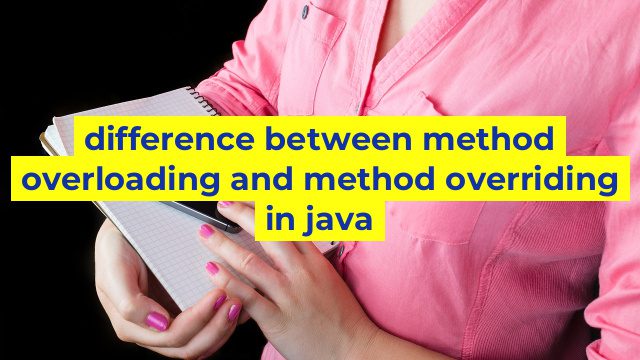Difference Between Method Overloading and Method Overriding in Java
In object-oriented programming with Java, two concepts to keep in mind are method overloading and method overriding. While the two may seem similar at first glance, they are actually quite different. Let’s take a closer look at each and the differences between them.
Method Overloading
Method overloading is when you define two or more methods with the same name in the same class. These methods have different parameters, and each method performs a different operation. When the method is called, Java chooses the appropriate method based on the number and type of arguments passed.
Here’s an example:
“`
public class Calculator {
public int add(int x, int y) {
return x + y;
}
public double add(double x, double y) {
return x + y;
}
}
“`
In this example, there are two methods with the name “add”, but they have different parameters. The first method is used when two integers are passed, and the second is used when two doubles are passed. By overloading the add method, the Calculator class is more versatile and can handle both integers and doubles with ease.
Method Overriding
Method overriding is when a subclass provides its own implementation of a method that is already provided by its parent class. The method in the parent class is known as the overridden method, and the method in the subclass is known as the overriding method.
Here’s an example:
“`
public class Animal {
public void speak() {
System.out.println(“Animal speaks”);
}
}
public class Dog extends Animal {
public void speak() {
System.out.println(“Dog barks”);
}
}
“`
In this example, the Animal class has a speak method that prints “Animal speaks” when called. The Dog class extends the Animal class and overrides the speak method. When you call the speak method on a Dog object, “Dog barks” is printed instead of “Animal speaks”. By overriding the speak method, the Dog class can customize the behavior of the Animal class to better suit its needs.
The Main Difference
The main difference between method overloading and method overriding is that method overloading is done within the same class, while method overriding is done in a subclass. Method overloading is used to define multiple methods with the same name, while method overriding is used to provide a new implementation of an existing method.
Ultimately, whether to use method overloading or method overriding will depend on what you are trying to achieve. When you need multiple methods with different parameters, it’s best to use method overloading. When you need to customize the behavior of an existing method, it’s best to use method overriding in a subclass.
Table difference between method overloading and method overriding in java
| Method Overloading | Method Overriding |
|---|---|
| Multiple methods with same name but different parameters can exist within the same class | Occurs when a subclass provides a different implementation for a method that is already defined in a parent class |
| Method signature must differ in terms of number of parameters, type of parameters, or sequence of parameters | Method signature must be the same in terms of name, return type, and parameters |
| Compile-time polymorphism | Runtime polymorphism |
| Used to provide different ways of invoking the same method | Used to provide different implementations for the same method |
